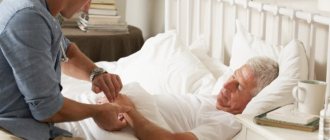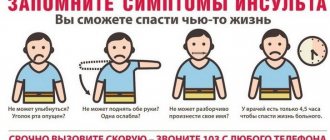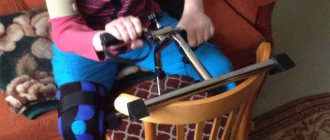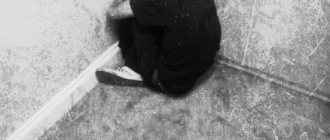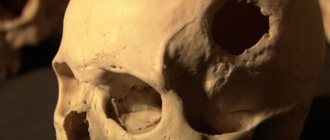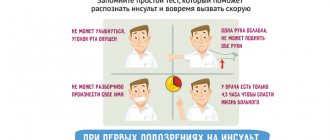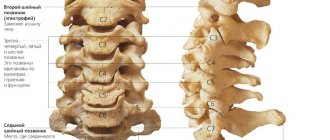General rules and recommendations
To reduce the severity of the negative consequences of a stroke, it is important to provide first aid correctly.
If you manage to detect the first signs of cerebrovascular accident, you should immediately call first aid. This is a sudden acute headache, increased blood pressure, numbness of one part of the face, vomiting, hemorrhage in the retina. First aid is as follows:
- Do not give food or drink to the person. Otherwise, you can cause paralysis of the organs responsible for swallowing.
- If vomiting occurs, the victim's head is turned to the side, which avoids the mass getting into the respiratory tract.
- A person in the throes of an attack is prohibited from making sudden movements.
- Compressive elements of clothing are removed from the patient: the collar, belt, and tie are loosened.
- If, after measuring the pressure, it was possible to detect its increase, it is allowed to give the person the appropriate pill.
In case of loss of consciousness, arrhythmia of breathing and pulse, cardiopulmonary resuscitation measures are carried out.
Recovery of patients who have suffered a stroke is a rather long and gradual process, which is carried out in several stages. Immediately after first aid is provided, the person is placed in the intensive care unit, where health status is monitored and the necessary treatment measures are carried out. Next, the patient is transferred to a neurological hospital, where doctors fight to restore the affected brain cells.
However, it is possible to adapt a person to life as much as possible at the expense of other neurons that were not damaged during the acute circulatory disorder. How speech can be restored after a stroke in each specific case depends on the degree of brain damage. Generally accepted rehabilitation methods include sessions with a speech therapist.
Work of the patient’s relatives with a speech therapist-aphasiologist
The importance of cooperation between family members and the speech therapist working with the patient cannot be ignored. Often the speech therapist invites relatives to attend some classes so that they can understand the methodology and technique of performing the exercises. After all, the key to results is regular and thorough work.
It is important that relatives maintain a positive attitude in the patient and provide him with psychological support. However, in no case should you overload the patient in an effort to achieve results as quickly as possible.
Here, relatives will also be helped by communication with a speech therapist, who will be able to explain the essence of the processes taking place and tell them how to do homework to correct speech disorders.
Advice from a speech therapist to family members of a stroke patient:
- Do not limit communication with a relative, even in case of significant speech impairment. Calm, positive conversations on topics that interest him stimulate him to engage in dialogue and do not allow him to feel alienated from society.
- Try not to express dissatisfaction with the slow results of speech restoration or incorrectly performed exercises. The speech therapist always tries to develop a sense of success in the patient; a positive attitude gives strength and desire to work further.
- Carefully follow your speech therapist's instructions for doing your homework . Remember that only a specialist knows how to help your relative.
- Do not overload the patient; excessive loads, even with good aspirations, can lead to the opposite result.
- Limit your TV viewing as it can also contribute to overload.
Support your relative in his activities, emphasize even minor achievements and do not abandon corrective efforts. In cooperation with a specialist, you can completely restore your speech!
Why does the ability to speak disappear?
During a stroke, blood supply to the cerebral structures is cut off and brain cells die. When the lesion affects the speech centers, diction disorders develop or aphasia develops, when the person completely loses the ability to speak.
The second, less dangerous reason is paralysis of the facial muscles. People lose the ability to speak normally due to the fact that half of the tongue “does not obey” and full articulation is not possible.
Based on the nature of the disorders that arise, several types of aphasia are distinguished:
- Total. Stroke patients do not speak or understand words addressed to them. Consciousness is confused, complete amnesia is possible.
- Sensory. Develops with damage to the temporal lobes (Wernicki's center). The person can partially speak, but does not understand the meaning of the words.
- Motor. The brain centers are not damaged, problems with articulation appeared due to paralysis of the tongue and face.
- Amnestic. Its manifestations are similar to sensory, but patients lose the ability to recognize the names of objects.
- Semantic. People cannot understand complex sentences and communicate using short, simple phrases.
The technique for restoring speech after a stroke is selected taking into account the mechanism of the disorder. Motor aphasia is easily eliminated, but total loss of speech requires a complex rehabilitation program and is rarely successful.
Types of aphasia
Aphasia is a systemic disorder of already formed speech function. This pathological process causes its negative impact on various forms of speech activity.
The following types of aphasia are distinguished:
- Motor - Broca's area is affected. The result of this pathology is a complete absence of speech.
- Acoustic-gnostic - Wernicke's area is affected. Analysis and synthesis, phonemic hearing are impaired, leading to the inability to understand spoken speech.
- Afferent motor – the lower parts of the postcentral cortex are affected. It is difficult for the patient to find a separate articular position to reproduce the sound.
- Amnestic-sematic - the posterior temporal and anterior parietal parts of the cerebral cortex are affected. The patient forgets phenomena and objects, and the understanding of grammatical structures is impaired.
- Dynamic – the posterior frontal parts of the brain are affected. It is difficult for a person to build an internal program of statements and implement it in external speech.
Classification and symptoms of speech disorders
For aphasia after a stroke, treatment measures begin when the threat to life disappears and the patient’s condition becomes stable. In case of an ischemic attack, if speech disturbances appear, treatment is carried out from 1-3 days, and when a cerebral hemorrhage occurs - on days 5-7.
The recovery method is selected individually, taking into account the mechanism of aphasia and the source of damage to brain structures.
Methods for restoring speech after a stroke depend on the stage of the post-stroke period. At an early stage:
- drug therapy;
- massage;
- classes with a speech therapist.
But in the hospital they only outline the path to recovery, and further treatment measures will be carried out at home. The patient's relatives are told in detail what to do to regain speech.
At the time of discharge, neurologists cannot give an accurate prognosis. The success of rehabilitation measures carried out at home depends not only on the severity of brain damage, but also on the regularity of the exercises. The patient’s psychological attitude also plays an important role - we need to help the person believe that he will be able to speak normally again.
Drugs for speech restoration after a stroke at an early stage are used to limit the lesion and improve the nutrition of nervous tissue. Patients are prescribed:
- nootropics (stimulate regeneration and help restore the functions of brain cells);
- antihypertensive drugs (necessary for critical increases in blood pressure);
- blood thinners (reducing blood viscosity improves cerebral circulation);
- diuretics (used to reduce swelling of the brain tissue).
Additionally, to stimulate recovery processes, the following can be used:
- Gliatilin;
- Ceraxon;
- Actovegin;
- Mexidol.
Medications can reduce the severity of brain disorders, but medications alone are not enough to restore speech function.
Before performing exercises to restore speech, you should remember a few rules:
- From simple to complex. There is no need to force things; you need to start with simple movements of your lips and tongue.
- Praise for the slightest success. If a stroke patient believes in himself, speech restoration will be more successful.
- Avoid overwork. If a person is tired or has lost interest, it is better to postpone the lesson.
The first exercises for speech development are carried out under the supervision of a speech therapist in a hospital setting. During this period, the nature of the deviations that have arisen is assessed, and effective exercises are selected that need to be performed at home. But you shouldn’t get carried away: to achieve success, it’s enough to do the suggested movements 5-10 times every day.
The practical exercises recommended below will help restore articulation and improve the functioning of the facial muscles. Here are a few movements from the suggested recommendations on how to regain speech:
- Purse your lips in a tube and exhale air, making the sound “U”.
- Bite your teeth first on your lower lip and then on your upper lip. Helps restore tactile sensations. Bite lightly without damaging the tissue. If there is severe sensitivity disorder on the face, this exercise is not recommended.
- Smile, trying to raise the corners of your mouth symmetrically.
- Stick out your rolled tongue
- Smack your lips.
- Run your tongue over your teeth and soft palate, lick your lips.
- Slowly inflate and deflate your cheeks, trying to hold the air with the paralyzed and healthy part of your lips.
It is recommended to do gymnastics before starting speech therapy exercises. Warming up your facial muscles will help improve articulation and improve the quality of your exercises.
Massage
When speech is impaired after a stroke, the patient experiences additional disorders:
- salivation;
- “sagging” of the cheek and corner of the mouth;
- problems with eating (food falls out of the mouth while chewing).
Massage treatments will help improve muscle tone and restore impaired facial expressions. After the severity of the paresis decreases, it will become easier for the stroke patient to pronounce words.
Points on the face and tongue are massaged (the location must be checked with a specialist), gentle stroking and rubbing of the cheeks, forehead and chin are performed.
Parents remember that tongue twisters were selected for children with slurred speech to improve the articulation of sound. Restoring the diction of adults is carried out according to a similar scheme. When choosing tongue twisters to restore speech after a stroke, you must be guided by the following rules:
- Start with simple ones. First, choose short sentences of 1-3 that cause moderate difficulty in pronunciation.
- Add letters gradually. First you need to achieve articulation of 1-2 sounds, and then add the next ones. A large speech therapy load will cause overstrain of the speech apparatus in an adult.
- Add a game element to your activities. Mechanical pronunciation of words will help less than learning tongue twisters together. If there is a small child in the family who has difficulty pronouncing words, then a good option would be to simultaneously learn rhymes with the baby and with a relative who has suffered a stroke.
Note! For training the work of the lips, tongue twisters with the sounds “B”, “P” are most suitable, and for the tongue - “L” and “V”. Examples are given below.
With the sound “B”:
- White snow, white chalk, a white hare is also white. But the squirrel is not white - it wasn’t even white.
- The bull was blunt-lipped, the bull was blunt-lipped, the bull's white lip was dull.
With the sound “P”:
- Polya went to weed the fields.
- Pyotr Petrovich, nicknamed Perov, caught a pigtail bird; he carried it around the market, asked for fifty dollars, they gave him a nickel, and he sold it like that.
With the sound “L”:
- Have you watered the lily? Have you seen Lydia? They watered Lily and saw Lydia.
- We ate, ate ruffs from the spruce tree. They were barely finished at the spruce.
With the sound “B”:
- Vavila was getting wet on the sail.
- It is not clear whether the shares are liquid or not.
In addition to rhymes for speech development, it is recommended to use nursery rhymes and counting rhymes. When practicing at home, you need to interest the patient and help him believe in success.
Problems with speech after a stroke will disappear more quickly if a person recites rhymes or counting rhymes from time to time. As articulation is trained, a person will develop correct speech, facial expressions will improve, and self-confidence will appear.
In addition to massage and speech therapy, doctors recommend the use of herbal medicine. Decoctions and infusions from the following plants will help well:
- pine cones;
- viburnum;
- thyme;
- juniper;
- rose hip;
- strawberries;
- calendula.
Pine baths have a general strengthening effect. The essential oils contained in pine needles improve muscle mobility and improve a positive attitude. If there are contraindications for taking a general bath, you can do foot baths.
Speech problems that arise after a stroke can be of different types. Some people completely lose the ability to speak, but the thought process is not disrupted. In this case, non-verbal communication methods are used.
Many people who have suffered a stroke are simply embarrassed to talk and have difficulty communicating with others, including relatives. However, relatives should not give up, but should try in every possible way to return the victim to normal life.
Degrees of dysarthria
Speech impairment (dysarthria) can have varying degrees of severity, which speech therapists determine taking into account the severity of clinical manifestations and the level of intelligibility of the patient’s speech, understandable to others.
Based on this, dysarthria can be divided into the following degrees:
- Initial degree - the first is called erased dysarthria. Clinical manifestations are mild. Only a speech therapist can identify them. Characteristic symptoms include rare swallowing of syllables and inexpressive speech.
- The second degree is typical. In this case, changes in speech are more noticeable, but it is understandable to others. The changes inherent in grade 3 can be compared with the slurred speech of a drunk person.
- The third degree is pronounced. There is a significant impairment of speech function. Only relatives can understand what the patient is talking about.
- The fourth degree is complete distortion of speech or its absence.
It is completely possible to restore speech function in case of impairment of the 1st degree, while the 4th degree is practically impossible to correct.
Types of aphasia
Loss of speech after a stroke occurs as aphasia, a systemic disorder caused by local pathological changes in the cerebral cortex. Aphasia, in turn, is divided into several types:
- Total. Occurs in the first days after an attack. The person does not speak at all and does not recognize spoken speech.
- Motor. The next stage that follows after total aphasia is motor. Expressed in the absence of speech function. Despite the difficulties of communication, a person recognizes relatives and understands calls.
- Sensory. A person does not understand spoken speech, which is caused by an organic lesion of the center responsible for sound analyzes of oral speech.
- Semantic. The patient understands simple addresses and statements, but difficulties remain in understanding complex speeches.
- Amnestic. It is difficult for a person to name objects, but repeated, dialogical, spontaneous speech functions are not impaired.
Such speech dysfunctions, which disappear after a stroke, can be corrected by special rehabilitation measures: pedagogical, psychological, social.
Speech disorder after an attack (stroke) is caused by damage to the corresponding areas of the brain. For example, if an ischemic stroke occurs, blood circulation in the organ is disrupted, and with a hemorrhagic stroke, local hemorrhage occurs.
Such pathological changes cause cell death in the speech center or cessation of the transmission of nerve impulses from the organ cortex to the vocal apparatus. How pronounced the speech changes will be depends on the part and extent of the brain damage.
Exercises to do on your own
Self-study plays a huge role in quickly improving speech function. After discharge, the patient periodically visits a speech therapist, who assesses for improvements and recommends what activities should be performed.
Each exercise should be repeated 10 times:
- Pull your lips into a tube and fix them in this position for a few seconds.
- Lightly bite your upper lip with your lower teeth.
- Reach the upper jaw towards the chin.
Language tasks:
- Pull out your tongue with a tube.
- Stretch your neck forward as much as possible, while your mouth is open and your tongue sticks out as much as possible.
- Perform the previous exercise, sounding it with hissing.
- Stretch your neck forward and form your lips into a tube.
- Lick your lips in a circle, first in one direction, then in the other.
- Make “clicking” sounds.
- Pull your tongue towards your nose, then your chin.
The lesson should end with positive exercises: blowing kisses, smiling with your teeth exposed, and then smiling with your lips covered. Excellent results are observed in patients in group classes, where they can support each other.
Important! A patient who has suffered a stroke should recite tongue twisters, read speech therapy texts aloud, hum songs and build logical chains.
For slurred speech and to improve your voice, it is recommended to massage your tongue with a regular toothbrush in the morning and evening. This exercise relaxes the organ and helps improve speech.
How long does it take for speech to recover?
The work of a speech therapist after a brain stroke is as follows:
- assessment of speech disorders;
- selection of tactics to eliminate speech deviations;
- correction of exercises taking into account progress in speech restoration.
After a stroke, a speech therapist with speech disorders becomes one of the important doctors to ensure complete rehabilitation.
Sessions with a speech therapist for bedridden patients are carried out at home, and patients who are able to move are recommended to visit the clinic. Most specialized institutions have a speech therapist for adults who can help eliminate speech disorders. An additional advantage for a stroke patient will be a change in impressions and possible participation in group exercises with “comrades in misfortune.”
A speech therapist for adults after a stroke is needed to avoid persistent speech disorders. The sooner recovery measures begin, the greater the patient’s chances of starting to speak normally.
Before restoring speech after an ischemic or hemorrhagic stroke, the doctor conducts a comprehensive diagnosis, based on the results of which he evaluates the condition of the patient’s speech components:
- determines how much a person understands the messages of others, including complex lexical and grammatical constructions, what is the volume of listening comprehension of words;
- how correctly the patient constructs his statements;
- there are or are no defects in internal speech, difficulties in formulating statements;
- How completely a person controls his speech.
Based on the results of the diagnosis, the doctor determines the method of correcting the disorders, for example, with the help of speech therapy classes or practical exercises. There is no need to hope that it will be possible to achieve speech restoration in a short period of time. In most cases, complex therapy using several methods is required.
Hemorrhagic and ischemic stroke require not only speech therapy and psychological classes to correct disorders, but also the use of certain medications that are prescribed at any stage of recovery:
- dehydration;
- neurometabolic cerebroprotectors;
- with a resolving effect;
- angioprotectors;
- vitamin products;
- anticonvulsants;
- hepatoprotectors;
- drugs to regulate emotional and behavioral states.
Any drug is prescribed on an individual basis, taking into account the characteristics of speech dysfunction and the degree of changes.
Classes with a speech therapist
A speech therapist will tell you what to do if you lose speech after a stroke during the lesson. First of all, the doctor determines the characteristics of the dysfunction, according to which he individually draws up the stages of recovery. Speech therapy exercises in 30% of cases make it possible to correct severe disorders already at the stage of discharge from the department.
Next, classes continue to be carried out at home, but from time to time (every month or week) they visit a specialist to determine the level of speech restoration. You can achieve the return of correct speech by observing the following principles of rehabilitation:
- systematic observation of reactions to loud and quiet sounds and voices;
- gradual increase in speech load during lessons;
- teaching pronunciation by observing how a person understands the meaning of spoken speech structures;
- greater focus on what is interesting to the patient, taking into account his wishes;
- using musical techniques, for example, learning names and words while singing along to your favorite song;
- a combination of oral speech and drawing: if it is impossible to pronounce a word, the patient can draw what it means.
After a person is able to pronounce individual words, at least a minimum volume, he can study tongue twisters for speech development.
To normalize speaking function, relatives are recommended to carry out exercises with the patient to restore speech after a stroke at home. You need to immediately understand that the exercises included in the complex for a person who has suffered a stroke will be very difficult.
So, an approximate set of speech gymnastics that will help restore speech in an adult:
- fold your lips into a tube, then return them to the original position, try to hold in both positions for 5 seconds;
- grab the lower lip with your upper lip, hold for 5 seconds, then return to the starting position (do the same with the lower lip, trying to grab the upper);
- stick out your tongue as far as possible, hold in this position for 3 seconds;
- lick the upper and lower lips, moving from right to left, then vice versa;
- Fold your tongue into a tube, stick it out and hold in this position for 3 seconds.
In combination with speech loads, writing training is carried out.
Physiotherapeutic procedures are prescribed, including electrical pulse stimulation of facial muscles, magnetic therapy, laser therapy, mud therapy, and manual therapy.
A person who has suffered a stroke is advised to eat properly, including vegetable oil, seafood, vegetables and fruits, which include fiber and folic acid. It is important to regulate your drinking regime by drinking at least 2 liters per day. liquids.
Animal fat, smoked meats, spicy, fried, pickled, and confectionery foods are removed from the diet. Limit salt, strong tea and coffee to a minimum. Alcohol is prohibited.
Traditional medicine is no less effective. For example, to prepare decoctions and infusions, you can use St. John's wort, thyme, strawberries, calendula, and juniper. Such funds help increase the protective function of the body and normalize the activity of blood vessels in the brain.
How quickly function can be restored, and what the prognosis for speech loss is, depends on the level of pathological changes in the brain. The recovery period is also influenced by the speed of learning and the characteristics of the rehabilitation period.
| Type of attack and presence of consequences | Recovery time |
| Ischemic type: minimal neurological defects, including changes in speech function | Complete rehabilitation after 2-3 months |
| Ischemic or hemorrhagic type: pronounced neurological changes, persistent deficit of speech function | Complete rehabilitation after several years, and sometimes more |
| Ischemic or hemorrhagic type: severe neurological changes, complete loss of speech, paralysis of one side of the body | Complete rehabilitation is impossible |
According to statistics, complete restoration of speech is often possible in cases of ischemic stroke. Longer recovery of function is observed in persons who have suffered a hemorrhagic attack.
If you were unable to avoid a stroke, there is no need to despair and give up. A person’s attitude is of great importance in recovery. It has been scientifically proven that a positive attitude towards the problem and the desire to return lost functions many times faster helps to fully recover.
Home rehabilitation
The main course of treatment is set by a speech therapist. After all, the selection of exercises, techniques, and determination of the type of aphasia requires special knowledge and experience. Without them, it’s easy not to calculate the load and lose the most effective time for recovery.
Objectives of home rehabilitation:
- Support your loved one. During rehabilitation, most patients experience emotional decline. Bad mood is aggravated by social isolation, physical suffering, dependence on others, and slow progress. Your support and approval will help the patient overcome this difficult period and not give up what he started.
- Perform sets of exercises prescribed by the speech therapist. Regularity, completeness of classes, quality of assignments are prerequisites for a good result. Remind your loved ones about the need to exercise, motivate them to do it.
- Taking and monitoring medications. Impaired memory and ability to focus are the most common consequences of a stroke. Because of them, many patients forget to take medications. It would be great if someone at home could remind you of this.
When performing the exercises on your own, follow these recommendations:
- focus on the task at hand;
- During classes, nothing should distract you. Make sure that everything you need, including water and auxiliary items, is at hand;
- do not hurry;
- Don't be lazy, but don't forget about breaks.
In case of speech disorders, it is very important to follow the basic rules:
- Talk to the patient, even if he does not respond to calls. The process stimulates the work of brain cells responsible for speech perception. This also helps activate the neurons involved in its reproduction.
- Do not overtire the patient with excessive attention and constant training. Even the simplest actions and exercises require a considerable amount of effort from him. Therefore, it is important to maintain a balance between work and rest.
- Encourage your loved one, rejoice in his successes. This will inspire him for further work. Never say in the presence of a patient something that he should not hear.
- Speak in a calm, friendly tone, clearly and slowly. If you need to repeat it, repeat it.
- Remind your loved one to speak slowly and as clearly as possible. If unsuccessful, suggest taking a break. After 2-3 minutes, ask to repeat what was said.
- Invite the patient to sing difficult words when difficulties arise with their pronunciation.
- Avoid complex speech structures and vocabulary. Sentences should be short and concise.
- Expect backlash. Many stroke survivors respond late. This pause sometimes lasts up to 30 seconds.
- Accompany your words with illustrations. Point to the objects you are talking about, show photographs of events.
- Change the topic of conversation gradually.
- Ask your loved one to repeat unclear fragments of words to you.
How long to wait for speech restoration
It is impossible to say how long it will take for speech to be restored after a stroke. The speed of recovery is affected by:
- Preservation of articulation ability. When speech has disappeared and a person makes only mooing sounds, it is difficult to teach him to speak again.
- The nature of aphasia. When the cause is a dysfunction of the facial muscles, learning to fully pronounce sounds is easier. Patients who cannot remember the name of an object or action have to be re-taught words and explained how to construct phrases to express thoughts.
- Features of ONMK. Speech recovery in patients after an ischemic stroke occurs faster than in persons after a cerebral hemorrhage.
- Caring for loved ones. Relatives who regularly do speech exercises with a stroke patient and encourage the person with small successes will help better than classes with a speech therapist after a stroke. The doctor will only help you create and gradually adjust the rehabilitation program.
Even taking into account all the factors, it is difficult to determine how long it takes for speech to be restored after a stroke. The patient’s relatives are warned that speech functions will have to be trained for a long time: from several months to a year, and it is unknown how long it will take for the stroke patient to speak fully. There are cases in medicine where patients learned to speak for several years until they achieved success.
In addition, neurologists and speech therapists immediately warn that rehabilitation measures do not provide a 100% guarantee. Whether speech is restored depends first of all on the type of damage to the speech centers, and then on the quality of the treatment provided.
Speech therapy exercises at home
Speech therapists, contrary to prejudice, work not only with young children with undeveloped speech; their professional responsibilities also include helping adults who have lost speech skills after a stroke or other serious injury that affected the central nervous system.
There is a set of exercises for recovery processes after a stroke - after 3-5 sessions with a professional speech therapist, relatives and other caregivers will be able to repeat them and work with the patient on their own.
Treatment prognosis
With motor aphasia, when it is difficult to speak due to paresis of the facial muscles, the prognosis is favorable. If treatment and speech therapy sessions are started immediately, most patients will fully recover their ability to speak.
In older people, due to age-related slowdown of metabolism, facial expressions are not always fully restored, so minor speech impairments persist: a lisp, unclear pronunciation of some sounds. But these deviations are moderate and a person can fully communicate with family and friends.
Amnestic and sensory aphasia require long-term work. The stroke patient is taught to first recognize words or objects, with additional work on articulation. Complete recovery in these types almost never happens - after long sessions it is possible to teach a person to perceive words and recognize relatives. Most often, this group of people has a limited vocabulary, and learning new concepts is difficult.
With semantic aphasia, it is only possible to improve diction and reduce paresis of the facial muscles. Due to damage to brain structures, such people will be able to communicate only in simple phrases.
After a stroke, recovery is not always possible, but this does not mean that you need to refuse to visit a speech therapist or not do speech gymnastics. In the early recovery period, if the patient is conscious and able to perform exercises, it is necessary to exercise. Even if diction is not fully restored, improving articulation and reducing the severity of the paresis will help with subsequent rehabilitation.

